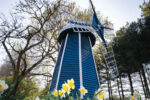Why So Many Indiana Gardeners Fall In Love with Bell-Shaped Clematis

Photo credit: iStock/fotolinchen
Many gardening aficionados are fans of the large-flowering types of clematis called the Queen of Vines. But the lesser-known bell-shaped clematises can be climbers or trailers, serving multiple purposes in the landscape.
The bell-shaped clematises quickly become a gardener’s favorite. They are easy to grow, versatile, perfectly hardy for Indiana weather, have few or no problems with diseases, are deer- and rabbit-resistant, and pollinators like them.
A personal favorite of mine is Rooguchi, which is loaded with deep blue blooms all summer as it climbs an obelisk at the end of a bed. Another favorite is Pagoda, which has pink flowers with petals that flare beautifully at the tips. Both of these (and many other bell-shaped varieties) are climbers.
Ground Trailers Too
In this rough and tough category come some ground-trailing clematises. Sometimes they are called bush clematises. “Mrs. Robert Brydon” (C. heracleifolia), a favorite introduced in the 1930s, scampers along the ground with small, pale lavender bell-shaped flowers. The petals eventually roll back to reveal bright white stamens.
Another easy-peasy trailer is simply called bush clematis. This one has small blue bell-shaped flowers that pop up among perennials to extend summer color in the landscape bed.
Clematises have beautiful seed heads, the part that remains on the plant after the petals fall away. The stamens glisten in the frost, catch bits of snow and hold their looks through winter.
See more: Native Wildflowers Offer Spring Awakenings
Planting Tips

Photo credit: iStock.com/BirdImages
Grow in full sun (six or more hours) or partial sun (four to six hours). Plant the clematis root ball so that the top is slightly below the soil surface. Water well, especially during the first year to make sure the clematis gets established. Fertilizer usually isn’t necessary. It’s more important to water periodically during hot, dry spells to keep the plant blooming.
You may have to help the plant climb. The leaf stem twines around the structure. At most, that leaf stem, called the petiole, can only wrap around a ¾-inch or less round or square piece. String, bamboo stakes or wire mesh may be necessary to help the plant climb.
A Warning
Sweet autumn clematis is an aggressive, invasive species in Indiana, so please don’t plant. Its white, fragrant flowers can be seen growing everywhere in fall. It self-sows like crazy. It is sold under two scientific names – C. paniculata or C. terniflora – and is similar to a native clematis (C. virginiana), which is hard to find in garden centers. One way to tell the difference is by the leaves.
See more: How to Decipher Gardening Catalogs










 My Indiana Home is produced for Indiana Farm Bureau members. Our mission is to connect you with the food you eat, the Indiana farmers who grow it and a rural lifestyle that is uniquely Hoosier.
My Indiana Home is produced for Indiana Farm Bureau members. Our mission is to connect you with the food you eat, the Indiana farmers who grow it and a rural lifestyle that is uniquely Hoosier.
Leave a Comment